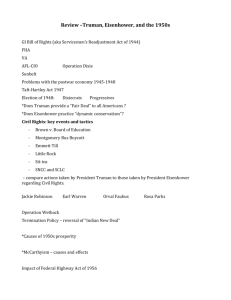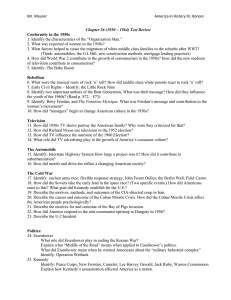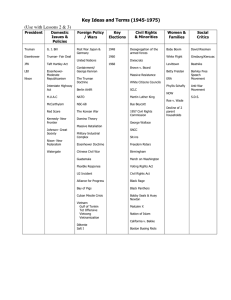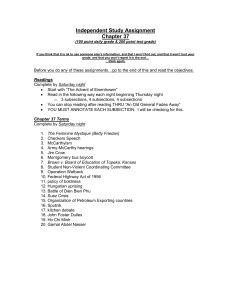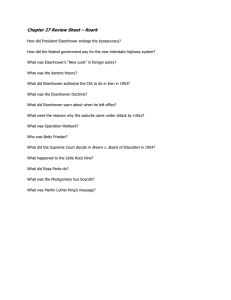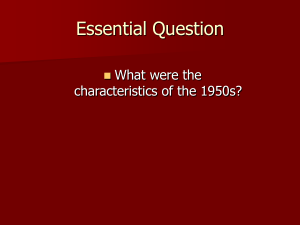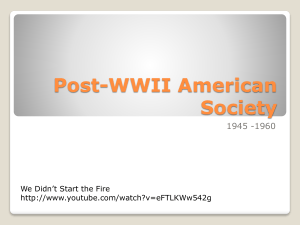The Confident Years, 1953-1964 Lecture/Reading Notes 1 (p. 324-330) I.
advertisement
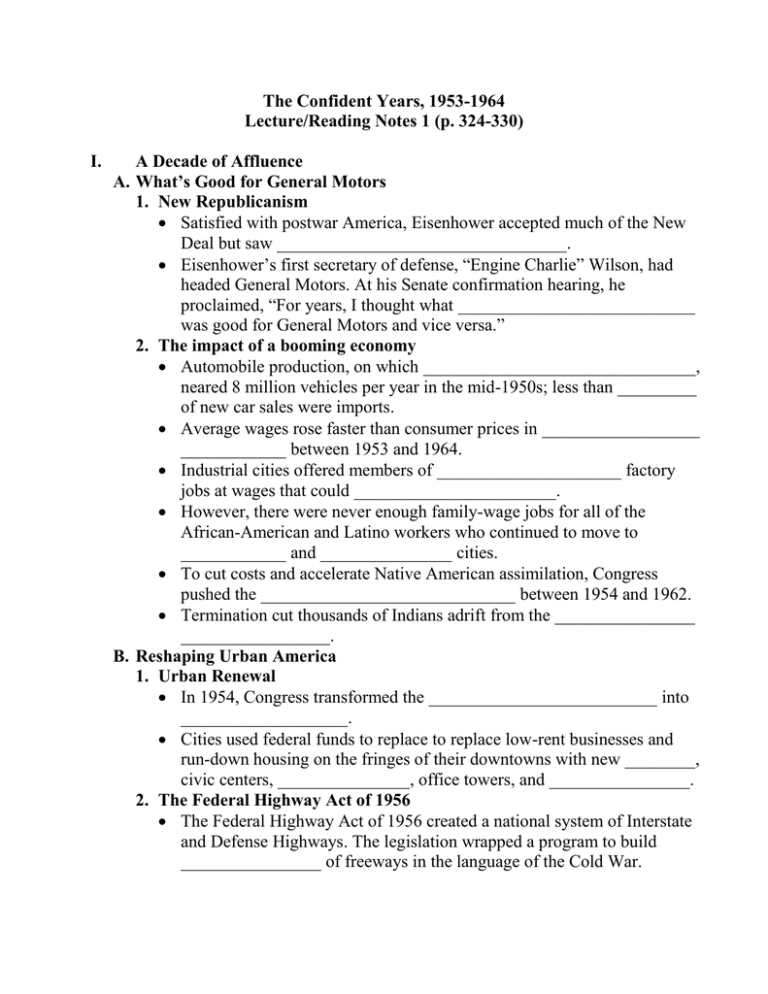
The Confident Years, 1953-1964 Lecture/Reading Notes 1 (p. 324-330) I. A Decade of Affluence A. What’s Good for General Motors 1. New Republicanism Satisfied with postwar America, Eisenhower accepted much of the New Deal but saw _________________________________. Eisenhower’s first secretary of defense, “Engine Charlie” Wilson, had headed General Motors. At his Senate confirmation hearing, he proclaimed, “For years, I thought what ___________________________ was good for General Motors and vice versa.” 2. The impact of a booming economy Automobile production, on which _______________________________, neared 8 million vehicles per year in the mid-1950s; less than _________ of new car sales were imports. Average wages rose faster than consumer prices in __________________ ____________ between 1953 and 1964. Industrial cities offered members of _____________________ factory jobs at wages that could _______________________. However, there were never enough family-wage jobs for all of the African-American and Latino workers who continued to move to ____________ and _______________ cities. To cut costs and accelerate Native American assimilation, Congress pushed the _____________________________ between 1954 and 1962. Termination cut thousands of Indians adrift from the ________________ _________________. B. Reshaping Urban America 1. Urban Renewal In 1954, Congress transformed the __________________________ into ___________________. Cities used federal funds to replace to replace low-rent businesses and run-down housing on the fringes of their downtowns with new ________, civic centers, _______________, office towers, and ________________. 2. The Federal Highway Act of 1956 The Federal Highway Act of 1956 created a national system of Interstate and Defense Highways. The legislation wrapped a program to build ________________ of freeways in the language of the Cold War. Interstates __________________ of city-to-city travel. The highways promoted ____________________________ at the expense of railroads. As with urban renewal, the bulldozers most often plowed through ____________________ or ____________ neighborhoods. C. Comfort on Credit 1. The rise in consumer debt The 1930s had taught Americans to ______________. The 1950s taught them to _______________. Families financed their new houses with _____________ FHA mortgages and _____________ VA mortgages. The first large-scale suburban shopping center was _________________, which assembled all the pieces of the full-grown mall. At the start of the 1970s, the ___________________ (Visa, MasterCard) made shopping even easier. 2. High-intensity consumption and entertainment environments More extreme than the mall were entirely new environments for highintensity consumption and entertainment that appeared in the Southwest, such as _____________ with its ___________________. Opening in ______________, California, in 1955, ______________ was safe and artificial – a never-ending state fair without the smells and dust. D. The New Fifties Family Prosperity allowed children to finish school and young adults to marry right after high school. Young women faced strong social pressure to pursue _______________________________. Strong families, said experts, defended against Communism by teaching ________________________. By 1960, fully _____________ of households had television sets. Popular entertainment was now in the privacy of the home, rather than ___________. Magazines proclaimed that proper families maintained distinct roles for dad and mom, who was urged to find fulfillment in a ________________ and ______________. By 1960, though, nearly ______________ of all women held jobs, including ______________ mothers with children under 17. E. Inventing Teenagers Teenagers in the 1950s joined adults as _______________ of movies, __________, and automobiles. Many cities matched their high schools to the social status of their students: _______________________ for middle-class neighborhoods, vocational and technical schools for future factory workers, and separate schools or tracks for ________________________________. All teenagers shared rock-and-roll, a new music of the mid-1950s that adapted the rhythm-and-blues of _____________ for a ________________. F. Turning to Religion 1. The resurgence of evangelical Christianity Leaders from Dwight Eisenhower to FBI Director J. Edgar Hoover advocated churchgoing as an antidote for Communism. Regular church attendance grew from ________________ of the population in 1940 to ________________ in 1960. During the 1950s, the theologically and socially conservative _________ ___________ became the largest Protestant denomination. ___________ was a pioneer in the resurgence of evangelical Christianity that stressed an individual approach to ___________________________. 2. Growth of African American churches African-American churches were _______________________ as well as _________________________. Black congregations in Northern cities swelled in the postwar years and often supported extensive _______________________. In Southern cities, churches were centers for _________________ and training grounds for the emerging ___________________________. G. The Gospel of Prosperity Writers and intellectuals often marveled at the _______________ of Eisenhower’s America. Officially, the American message was that ____________ was a natural by-product of _________________. Vice President Richard Nixon claimed the “most important thing” for Americans was “____________________”: “We have so many different manufacturers and many different kinds of washing machines so that the housewives have a choice.” H. The Underside of Affluence 1. Michael Harrington’s The Other America (1962) Michael Harrington wrote The Other America (1962) to remind Americans about the “underdeveloped nation” of __________________ poor people who had missed the last two decades of prosperity. 2. C. Wright Mills’ The Power Elite (1956) The Power Elite (1956) described an interlocking alliance of _______ _____________, ________________, and _____________. The losers in a permanent war economy, said Mills, were economic and political democracy. 3. David Riesman Other critics targeted the alienating effects of __________________ and the ________________ of homogeneous suburbs. Sociologist David Riesman saw suburbia as the home of “other-directed” individuals who ___________________________. 4. The Housing Act of 1949Betty Friedan’s The Feminine Mystique In 1963, Betty Friedan’s book The Feminine Mystique followed numerous articles in McCall’s, Redbook, and the Ladies’ Home Journal about the _________________________________ who were expected to find total satisfaction in ___________________.
